ECG Cases 48 – ECG Interpretation in Cardiac Arrest
ECG Cases
FEBRUARY 13, 2024
The post ECG Cases 48 – ECG Interpretation in Cardiac Arrest appeared first on Emergency Medicine Cases.
This site uses cookies to improve your experience. By viewing our content, you are accepting the use of cookies. To help us insure we adhere to various privacy regulations, please select your country/region of residence. If you do not select a country we will assume you are from the United States. View our privacy policy and terms of use.

ECG Cases
FEBRUARY 13, 2024
The post ECG Cases 48 – ECG Interpretation in Cardiac Arrest appeared first on Emergency Medicine Cases.

American College of Cardiology
NOVEMBER 5, 2024
A small proportion of patients with STEMI treated via primary PCI experienced late ventricular tachycardia (VT) or ventricular fibrillation (VF), occurring one or more days following the procedure, but late VT or VF with cardiac arrest occurred rarely, especially among patients with uncomplicated STEMI, according to a study published in JAMA Network (..)
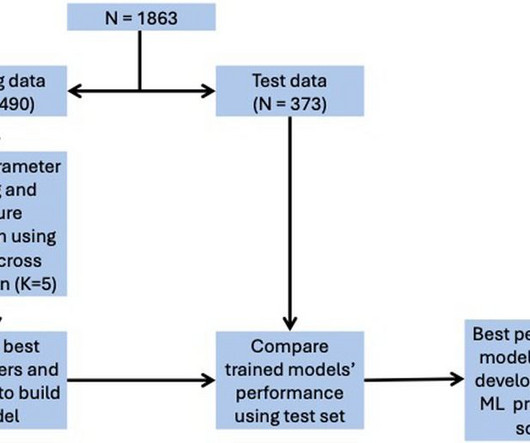
Frontiers in Cardiovascular Medicine
OCTOBER 9, 2024
The included variables were age, pre-hospital cardiac arrest, robust collateral recruitment (Rentrop grade 2 or 3), family history of coronary disease, initial systolic blood pressure, initial heart rate, hypercholesterolemia, culprit vessel, smoking status and TIMI flow pre-PCI. for in-hospital mortality, 0.78 for LVEF < 40%.
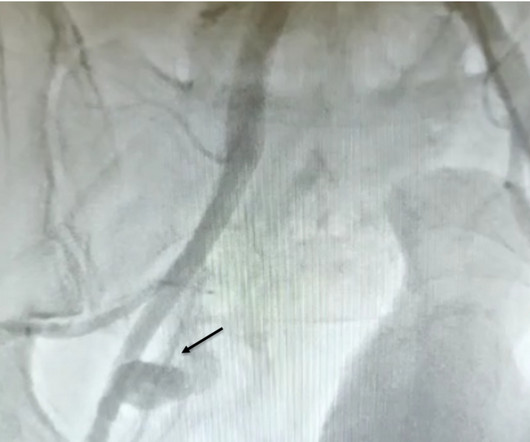
The British Journal of Cardiology
NOVEMBER 29, 2023
Primary percutaneous coronary intervention (PPCI) remains the gold-standard treatment for ST-elevation myocardial infarction (STEMI). We present the case of a man in his 50s, admitted with cardiac arrest secondary to inferolateral STEMI.
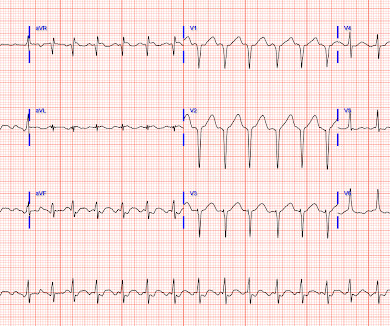
Dr. Smith's ECG Blog
JULY 9, 2024
Written by Pendell Meyers A man in his 50s was found by his family in cardiac arrest of unknown duration. Despite anticipation by many that the initial post-resuscitation ECG will show an obvious acute infarction — this expected "STEMI picture" is often not seen.
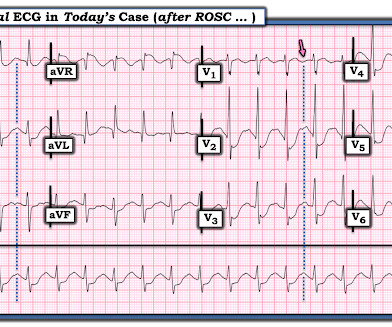
Dr. Smith's ECG Blog
JULY 25, 2024
But cardiac arrest is a period of near zero flow in the coronary arteries and causes SEVERE ischemia. After cardiac arrest, I ALWAYS wait 15 minutes after an ECG like this and record another. See these related cases: Cardiac arrest, defibrillated, diffuse ST depression and ST Elevation in aVR.
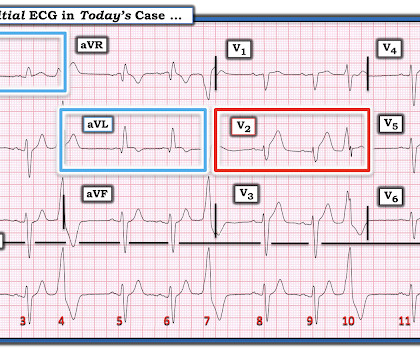
Dr. Smith's ECG Blog
JUNE 27, 2024
A patient had a cardiac arrest with ventricular fibrillation and was successfully defibrillated. COACT: The COACT trial was fatally flawed, and because of it, many cardiologists are convinced that if there are no STEMI criteria, the patient does not need to go to the cath lab. These studies did not address OMI ECG findings!!!
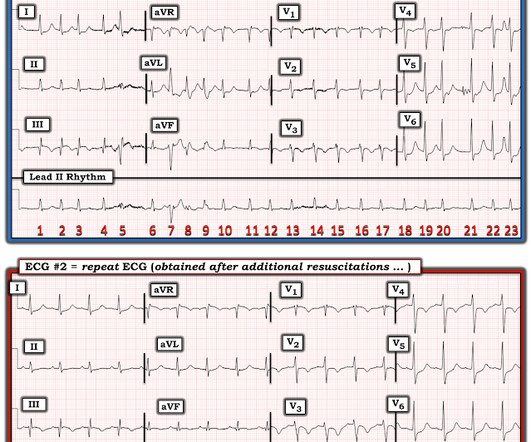
Dr. Smith's ECG Blog
OCTOBER 10, 2022
He had multiple cardiac arrests with ROSC regained each time. Then there is loss of pulses with continued narrow complex on the monitor ("PEA arrest") Learning Points: Sudden witnessed Cardiac Arrest due to ACS is almost always due to dysrhythmia. This patient arrested shortly after hospital arrival.

Dr. Smith's ECG Blog
JANUARY 21, 2023
ECG met STEMI criteria and was labeled STEMI by computer interpretation. J waves can also be induced by Occlusion MI (5), STEMI mimics including takotsubo and myocarditis complicated by ventricular arrhythmias (6, 7), and subarachnoid hemorrhage with VF (8). Take home : Not all STEs are STEMIs or OMIs. What do you think?

Dr. Smith's ECG Blog
FEBRUARY 22, 2024
A woman in her 50s with dyspnea and bradycardia A patient with cardiac arrest, ROSC, and right bundle branch block (RBBB). HyperKalemia with Cardiac Arrest. Peaked T waves: Hyperacute (STEMI) vs. Early Repolarizaton vs. Hyperkalemia What will you do for this altered and bradycardic patient?
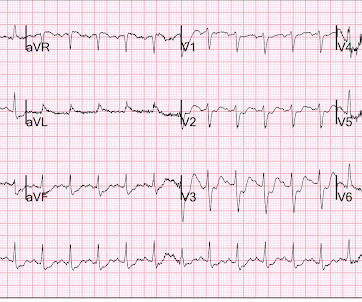
Dr. Smith's ECG Blog
SEPTEMBER 29, 2024
This certainly looks like an anterior STEMI (proximal LAD occlusion), with STE and hyperacute T-waves (HATW) in V2-V6 and I and aVL. How do you explain the anterior STEMI(+)OMI immediately after ROSC evolving into posterior OMI 30 minutes later? This caused a type 2 anterior STEMI.

Dr. Smith's ECG Blog
SEPTEMBER 20, 2011
This 80 year old with a history of CABG had a cardiac arrest. This is as clear a STEMI as you can get. Now, it is true that shortly after a non-ACS cardiac arrest, there can be transient diffuse ST depression, but not ST elevation in a coronary distribution, and there should not be a wall motion abnormality.
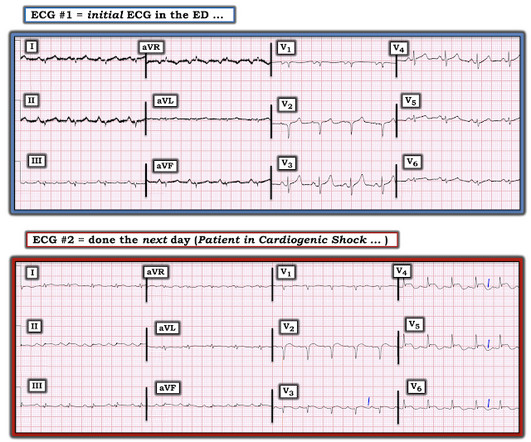
Dr. Smith's ECG Blog
NOVEMBER 12, 2020
In a series of 18 patients with COVID and ST elevation, 8 were diagnosed with STEMI, 6 of whom had an angiogram and it showed obstructive coronary disease. 12 All STEMI patients had very high cTn typical of STEMI (cTnT > 1.0

Ken Grauer, MD
FEBRUARY 3, 2024
Shortly after arrival in the ED ( E mergency D epartment ) — she suffered a cardiac arrest. BUT — Cardiac catheterization done a little later did not reveal any significant stenosis. Figure-1: The initial ECG in today's case — obtained after successful resuscitation from cardiac arrest. ( No CP ( C hest P ain ).
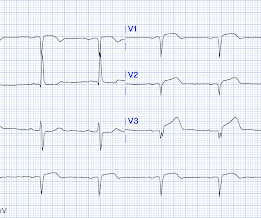
Dr. Smith's ECG Blog
OCTOBER 8, 2024
Subtle as a STEMI." (i.e., About 45 minutes after the second EKG, the patient was found in cardiac arrest. Later the next day, she went into cardiac arrest again. By the time I saw the repeat EKG, the patient was already in cardiac arrest. None of the 20 ever evolved to STEMI criteria.

Circulation: Cardiovascular Interventions
FEBRUARY 20, 2024
NH-IMRangiowas calculated based on standard coronary angiographic views with 3-dimensional-modeling and computational analysis of the coronary flow.RESULTS:Overall, ECC (a composite of cardiovascular death, cardiogenic shock, acute heart failure, life-threatening arrhythmias, resuscitated cardiac arrest, left ventricular thrombus, post-ST-segment–elevation (..)

Dr. Smith's ECG Blog
JUNE 21, 2023
You can subscribe for news and early access (via participating in our studies) to the Queen of Hearts here: [link] queen-form This EMS ECG was transmitted to the nearby Emergency Department where it was remotely reviewed by a physician, who interpreted it as normal, or at least without any features of ischemia or STEMI.
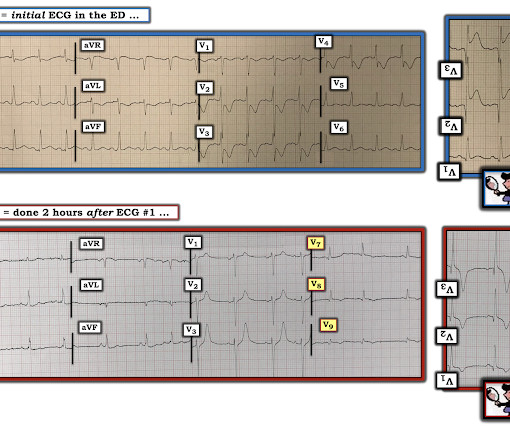
Dr. Smith's ECG Blog
SEPTEMBER 21, 2020
Are Some Cardiologists Really Limited by Strict Adherence to STEMI millimeter criteria? I was texted these ECGs by a recent residency graduate after they had all been recorded, along with the following clinical information: A 50-something with no cardiac history, but with h/o Diabetes, was doing physical work when he collapsed.
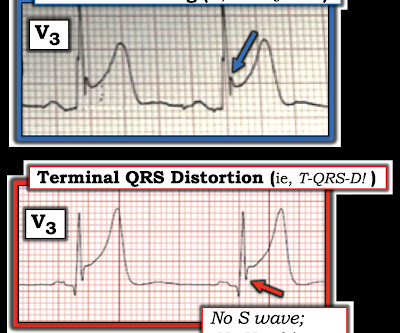
Ken Grauer, MD
JUNE 14, 2024
The ECG in Figure-1 — was obtained from a middle-aged man who presented to the ED ( E mergency D epartment ) in cardiac arrest. Prompt cath is therefore advised if the post-ROSC shows an acute STEMI. To Emphasize: The phenomenon of T-QRS-D is not needed in today's case to recognize the acute STEMI.
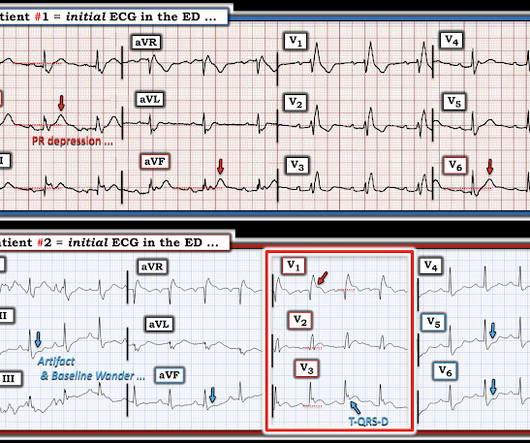
Dr. Smith's ECG Blog
OCTOBER 17, 2024
Past medical history included RBBB without other cardiac history, but old ECG was not available. The prehospital and ED computer interpretation was inferior STEMI: There’s normal sinus rhythm, first degree AV block and RBBB, normal axis and normal voltages. Vitals were normal except for oxygen saturation of 94%. Vitals were normal.
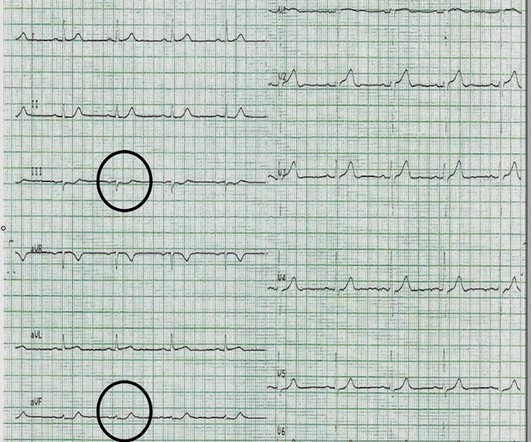
Dr. Smith's ECG Blog
OCTOBER 24, 2013
Appreciation of these subtle ECG findings could have helped to avoid a cardiac arrest and its resulting permanent disability 3. Ischemia on the ECG can be very subtle and is easily missed. Accurate interpretation requires a lot of skill, practice, and experience.
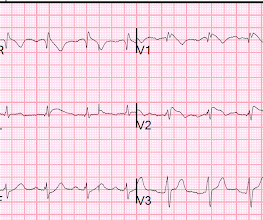
Dr. Smith's ECG Blog
JANUARY 25, 2017
911 was called and the medics recorded this ECG (unfortunately, leads V4-V6 are missing) Due to marked ST Elevation, the computer read was STEMI What do you think? See this post and associated case reports: Cardiac arrest, severe acidosis, and a bizarre ECG The patient was admitted and ruled out for acute MI by serial troponins.
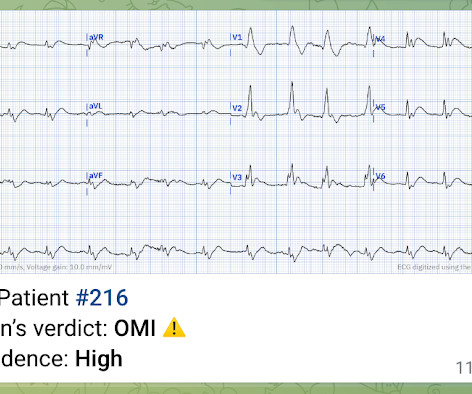
Dr. Smith's ECG Blog
JULY 14, 2023
Two recent interventions have proven in randomized trials to improve neurologic survival in cardiac arrest: 1) the combination of the ResQPod and the ResQPump (suction device for compression-decompression CPR -- Lancet 2011 ) and 2) Dual Sequential defibrillation.
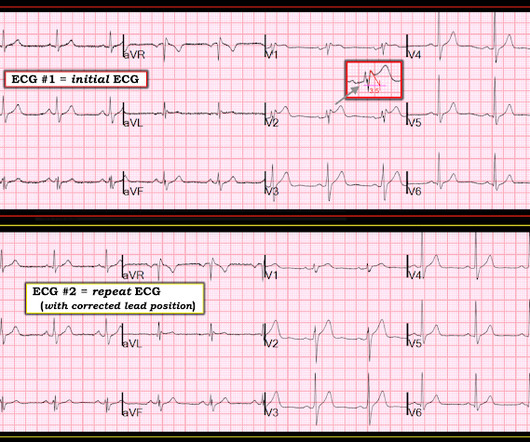
Dr. Smith's ECG Blog
NOVEMBER 28, 2018
Saddleback ST Elevation is almost never STEMI 2. An inverted P-wave in lead V2 implies lead misplacement too high Saddleback in STEMI: Here are the only 2 ECGs with V2 "saddleback" that I have ever seen which really represented an LAD Occlusion: Anatomy of a Missed LAD Occlusion (classified as a NonSTEMI) A Very Subtle LAD Occlusion.T-wave
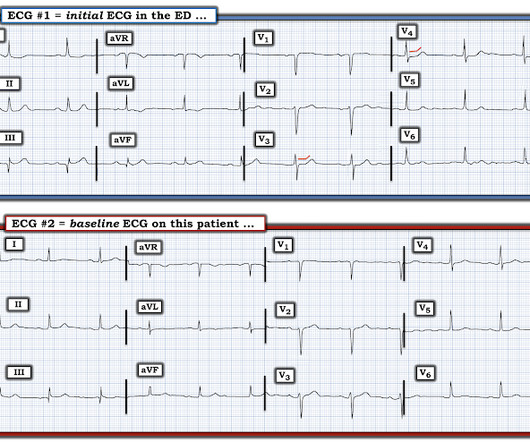
Dr. Smith's ECG Blog
NOVEMBER 23, 2022
About an hour later, he was then found on the floor in cardiac arrest in the ED. Sooner identification likely leads to better outcomes, and in this case may have allowed prevention of cardiac arrest and better long-term outcome. His initial troponin T was 15 ng/L (only two hours since pain onset).
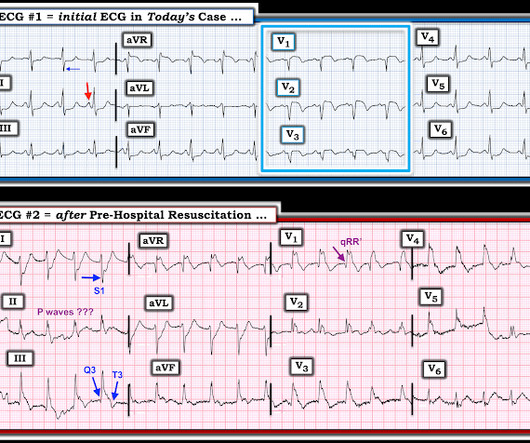
Dr. Smith's ECG Blog
JANUARY 8, 2024
She was diagnosed with a Non-STEMI and kept overnight for a next day angiogram. Medics recorded the above ECG and called a STEMI alert. The patient went into arrest pre-hospital. Her symptoms at the time ECG #1 was obtained were CP and SOB — yet interpretation of this initial tracing prompted a STEMI alert.
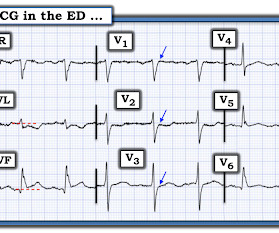
Dr. Smith's ECG Blog
AUGUST 19, 2023
This is diagnostic of infero-posterior OMI, but it is falsely negative by STEMI criteria and with falsely negative posterior leads (though they do show mild ST elevation in V4R). They were less likely to have STEMI on ECG, and more likely to be initially diagnosed as non-ACS.

Dr. Smith's ECG Blog
NOVEMBER 4, 2022
This has been termed a “STEMI equivalent” and included in STEMI guidelines, suggesting this patient should receive dual anti-platelets, heparin and immediate cath lab activation–or thrombolysis in centres where cath lab is not available. aVR ST segment elevation: acute STEMI or not? aVR ST Segment Elevation: Acute STEMI or Not?
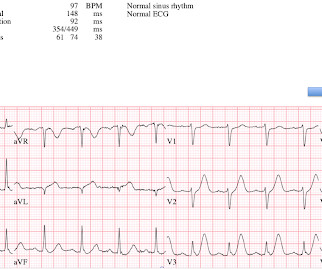
Dr. Smith's ECG Blog
OCTOBER 9, 2018
link] In this paper, in a department in which they state they have only 50 STEMI per year, they looked at only 8 days worth of triage ECGs for a total of 538. They did not find one STEMI on their triage ECGs (no surprise! We at HCMC have 30 walk-in STEMIs per year; the rest come by ambulance. Am J Emerg Med 36(10):1771-1774.
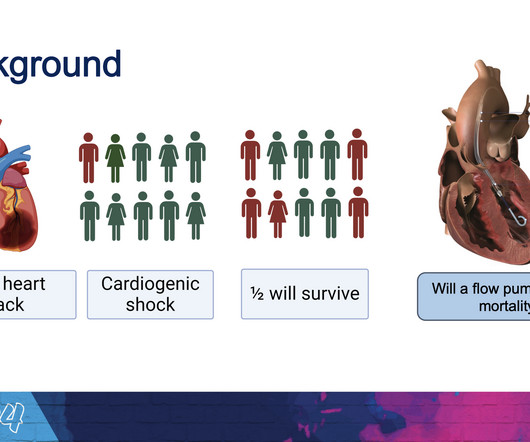
DAIC
APRIL 8, 2024
The new trial, called DanGer Shock , is the first trial powered to examine whether the use of micro-axial flow pumps can improve survival in ST-elevation myocardial infarctions (STEMI, the most serious type of heart attack) that are complicated by cardiogenic shock.
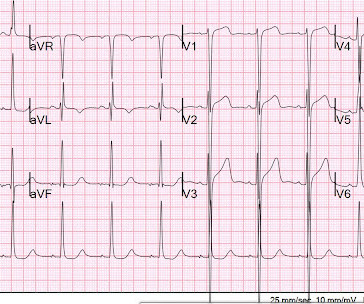
Dr. Smith's ECG Blog
OCTOBER 4, 2010
Thus, this patient had increased ST elevation (current of injury) superimposed on the ST elevation of LVH and simulating STEMI. The stress of the triathlon cause demand ischemia and ventricular fibrillation. He awoke and did well.
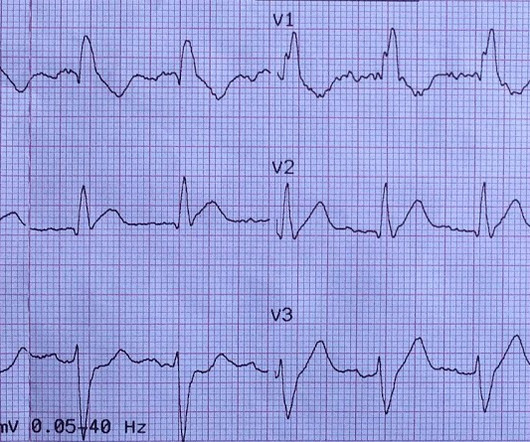
Dr. Smith's ECG Blog
NOVEMBER 19, 2014
Here are three more dramatic cases that illustrate RBBB + LAFB Case 1 of cardiac arrest with unrecognized STEMI, died. Furthermore, among 35 patients with acute left main coronary artery occlusion, 9 presented with RBBB (mostly with LAH) on the admission ECG.
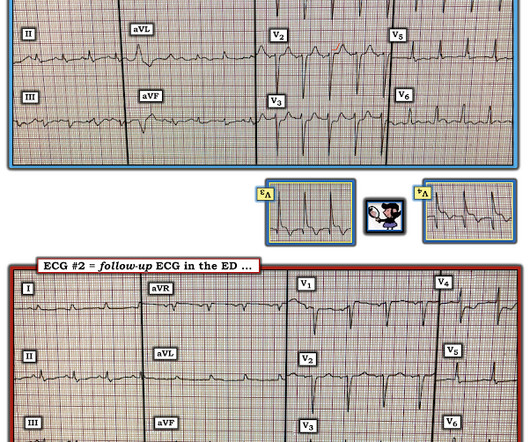
Dr. Smith's ECG Blog
OCTOBER 11, 2020
The provider contacted cardiology to discuss the case, but cardiology "didn't think it was a STEMI, didn't think he needed emergent cath." About two hours after admission, he suffered a cardiac arrest (whether it was VF/VT or PEA is not available) and expired. The whole paradigm is literally called "STEMI" vs. "NSTEMI."
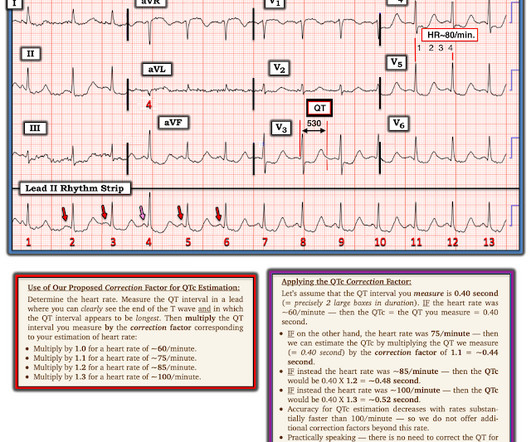
Dr. Smith's ECG Blog
OCTOBER 25, 2023
Polymorphic Ventricular Tachycardia Long QT Syndrome with Continuously Recurrent Polymorphic VT: Management Cardiac Arrest. A New Seizure in a Healthy 20-something More cases of long QT not measured correctly by computer (these are all fascinating ECGs/cases): Bupropion Overdose Followed by Cardiac Arrest and, Later, ST Elevation.

Dr. Smith's ECG Blog
JANUARY 4, 2021
Could this be Septal STEMI (STE in V1 and aVR, with reciprocal ST depression in V4-V6?), In Septal STEMI , transmural ischemia of the septum is recorded by the overlying lead V1 as ST Elevation. Lead III is also on the right and might manifest ST Elevation in Septal STEMI. with ADDED STE in III?
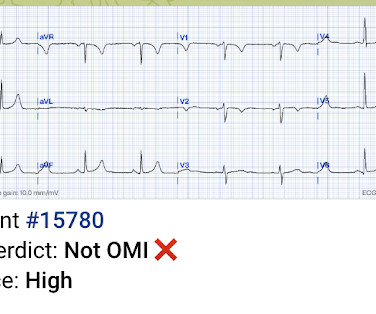
Dr. Smith's ECG Blog
AUGUST 1, 2020
He has done a lot of great work on cardiac arrest, including as co-author of our study on esmolol in refractory cardiac arrest, and much more with Keith Lurie. This was sent by Guillaume Debaty, from the Grenoble Region of France. See his Google Scholar profile here. Several of these are present in this case.
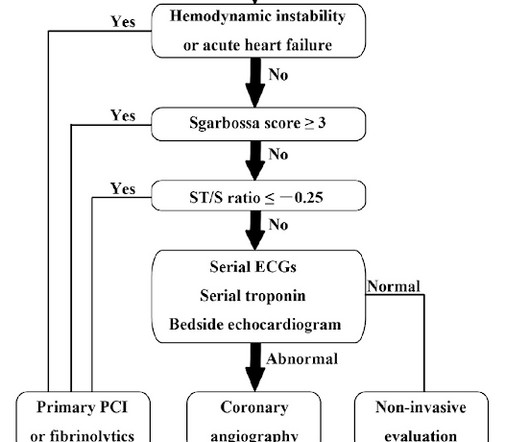
Dr. Smith's ECG Blog
JUNE 11, 2021
The patient was brought to the ED as a possible Code STEMI and was seen directly by cardiology. Similarly, STEMI guidelines call for urgent angiography for refractory ischemia or electrical/hemodynamic instability, regardless of ECG findings. On arrival, GCS was 13 and the patient complained of ongoing chest pain.
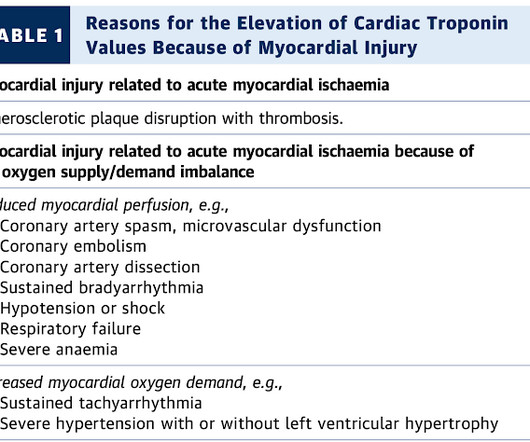
Dr. Smith's ECG Blog
MAY 19, 2020
This is a troponin I level that is almost exclusively seen in STEMI. I suspect this is Type 2 MI due to prolonged severe hypotension from cardiac arrest. So this is either a case of MINOCA, or a case of Type II STEMI. If the arrest was caused by acute MI due to plaque rupture, then the diagnosis is MINOCA.

Dr. Smith's ECG Blog
DECEMBER 15, 2015
It was a PEA or bradyasystolic arrest , not a shockable rhythm. Although most cardiac arrest from MI is due to ventricular fibrillation, some is due to high grade AV block, and so this could indeed be due to large acute STEMI. LV anterior STEMI does not give maximal ST elevation in V1. Is this an anterior (LV) MI?
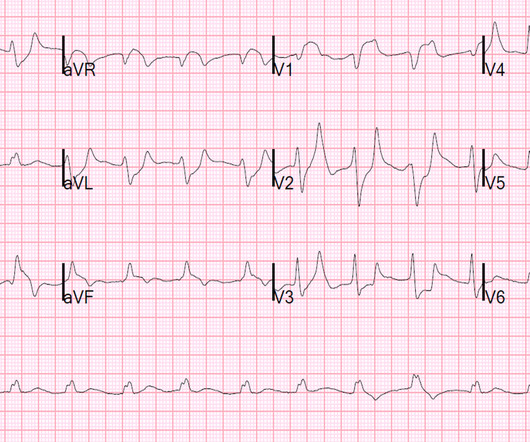
Dr. Smith's ECG Blog
JUNE 15, 2013
The cath lab was activated for STEMI. Unfortunately, the patient had a cardiac arrest on arrival to the cath lab, before return of the potassium. Hyperkalemia alone can cause inferior-posterior pseudo-STEMI: Notice that in both cases, the ST elevation is downsloping and the T-wave is inverted. The potassium returned at 8.4

Dr. Smith's ECG Blog
SEPTEMBER 16, 2015
It may be difficult to read STEMI in the setting of RBBB. There is, however, a long QT also, with abnormal T-waves, but this is not STEMI. This ECG was recorded prehospital, and the computer read STEMI, so the medics activated the cath lab: What do you think? The ECG is consistent with high lateral STEMI. Called 911.
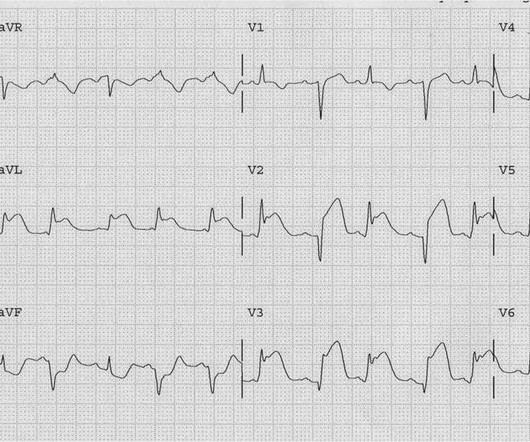
Dr. Smith's ECG Blog
DECEMBER 23, 2014
The patient was diagnosed with esophageal reflux and was being discharged by the nurse when he had a cardiac arrest. Anterolateral STEMI. The formula results in 23.43, just above the 23.4 He was defibrillated. Here is his post resuscitation ECG: Now the diagnosis is obvious.
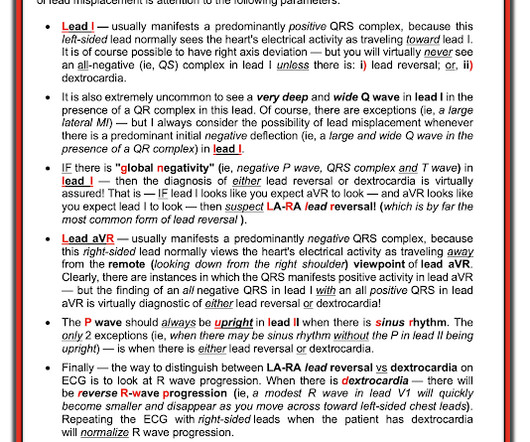
Dr. Smith's ECG Blog
MAY 5, 2022
Despite the clinical context, Cardiology was consulted due to concerns for a "STEMI". Hyperkalemia mimics STEMI and OMI in many distributions, but probably the most common is the Brugada morphology in V1-V2 which mimics anterior OMI for those who cannot recognize the Brugada pattern. HyperKalemia with Cardiac Arrest.
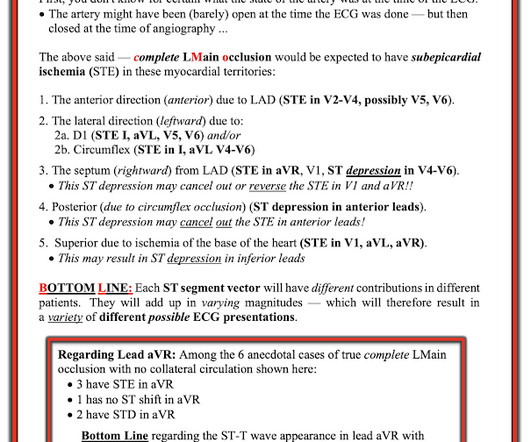
Dr. Smith's ECG Blog
JULY 21, 2024
The ECG shows obvious STEMI(+) OMI due to probable proximal LAD occlusion. The patient in today’s case is a previously healthy 40-something male who contacted EMS due to acute onset crushing chest pain. The pain was 10/10 in intensity radiating bilaterally to the shoulders and also to the left arm and neck. The below ECG was recorded.
Expert insights. Personalized for you.
We have resent the email to
Are you sure you want to cancel your subscriptions?


Let's personalize your content